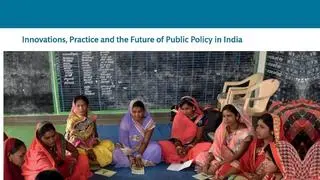Sujit Sahgal, who had a successful banking career of over 25 years, had kindled interests in the agriculture sector in 2020 with his maiden book A Wall Street View of Rural India. The book was released during the Covid pandemic and he gave himself some headroom to write his next book by penning a chapter “Future of Farming”. Given the fact that the media has not dealt with the future of farming in detail, Sahgal was requested by his well-wishers to expand on the theme. This was the seed that was sown to write this book Agribusiness and Technology - Revolutionizing the Future of Farming.
In penning this book, Sahgal has visited many farmers across the country and talked to them to understand their views and thoughts on agritech, their curiousness to learn and their willingness to adapt to new technologies.
In talking to as many farmers as he could, the author has come up with some very interesting findings that will not only help policymakers and government officials but also those in the private sector. Sahgal has tried to outline the solutions to many issues that have been dogging the agriculture sector for decades now. More importantly, he is reiterating some of the important points that have been discussed and debated all these years.
For example, community farming is one of the most widely discussed issues in the field of agriculture as most of the farmers are marginal and small farm holders. Sahgal says these small farms hamper economics at the farm level and investments. He advocates “land aggregation” possibly through safe leasing agreements, farming collectives and farmer producer organizations.
The author’s views have been reflected in the Associated Chambers of Commerce and Industry (Assocham) pre-budget memorandum this year. Assocham has called for repealing land ceiling laws to allow farmers to thrive economically.
SOLID state
Sahgal has come up with a SOLID - sustainable solutions, lucrative, independent and doubling income - farming model to keep farmers and their future generations interested in agriculture. This can be achieved only by making the core agricultural activity “sustainably profitable” on its own.
The author advocates liberalisation of farming from rules, regulations and restrictions to treat reforms in the sector with a different approach. Sahgal advocates allowing farmers to access markets through the electronic national agricultural market (e-NAM), choose crops without the minimum support price, get mini-storage infrastructure, easier financing, and enjoy liberal trade laws.
A feature of Sahgal’s presentation of various issues is the anecdotes he uses in each chapter to introduce the subject and the issues around it. One of the interesting aspects that the author has brought to light is that farmers accept only what they think is feasible.
The author explains how a tissue culture scientist told farmers that they could make ₹50,000 per acre annually against the ₹2,000-3,000 they were making if they followed his advice. The growers ignored his suggestion, dubbing him “mad”. The scientist realised his folly and told them that they could make ₹10,000. The farmers trusted him thereafter and followed his suggestions. Soon, they began earning ₹20,000 per acre annually.
Understanding nuances
Sahgal is clear in his view that policymakers, government officials, extension personnel and others “understanding the nuances is the key” to learning what farmers know and what they want.
One of the interesting suggestions that the author proposes is offering input access services and renting of equipment (FaaS) along with financial services such as effective insurance policies. Sahgal says FaaS is in huge demand from farmers producers organisations especially for small farmers for who it would be sensible to rent farm equipment.
Unlike those who tend to come up with a pessimistic outlook on India’s rural areas, Sahgal sounds optimistic and positive on the future of Indian farming. His viewpoints are embellished by various options and solutions to make farming profitable and more promising. Agribusiness and technology could well turn out to be a guide for those wanting to make agriculture profitable.
Book: Agribusiness and Technology - Revolutionizing the Future of Farming
Author: Sujit Sahgal
Published by SAGE Response Business Books
Pages: 246
Price: ₹550








Comments
Comments have to be in English, and in full sentences. They cannot be abusive or personal. Please abide by our community guidelines for posting your comments.
We have migrated to a new commenting platform. If you are already a registered user of TheHindu Businessline and logged in, you may continue to engage with our articles. If you do not have an account please register and login to post comments. Users can access their older comments by logging into their accounts on Vuukle.